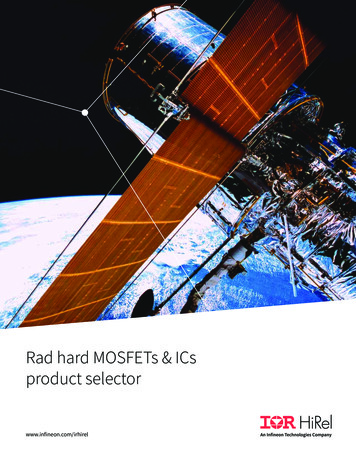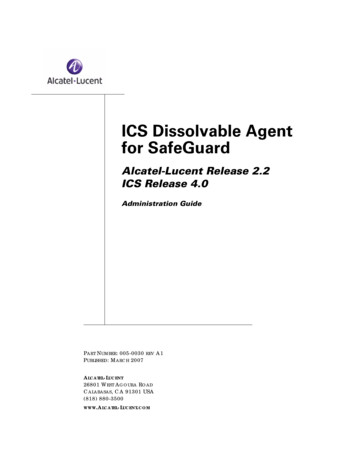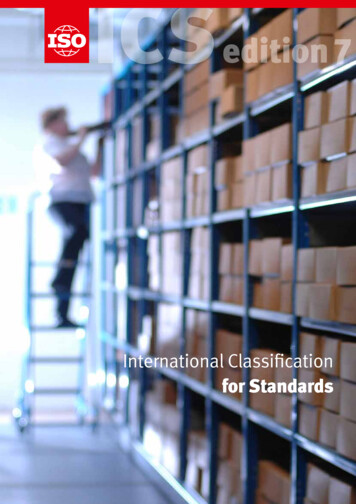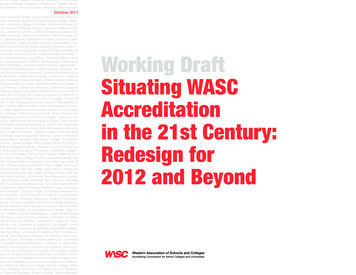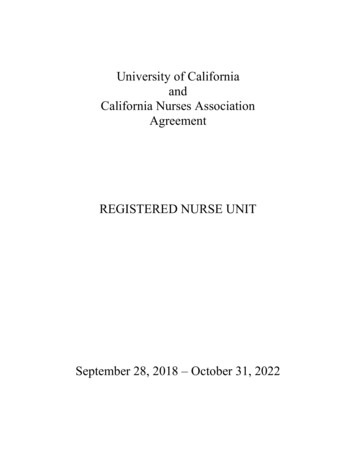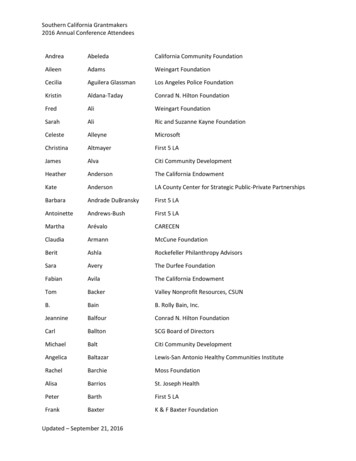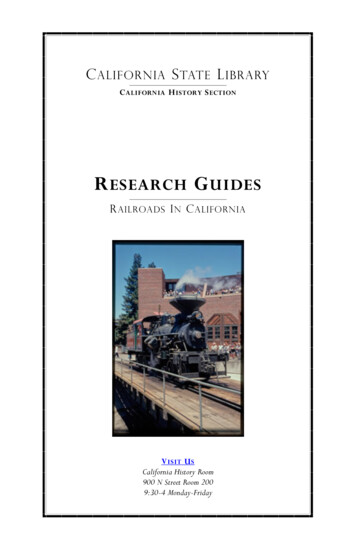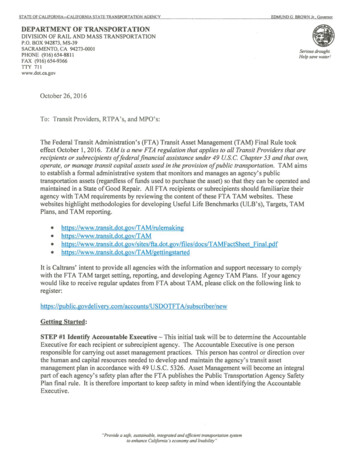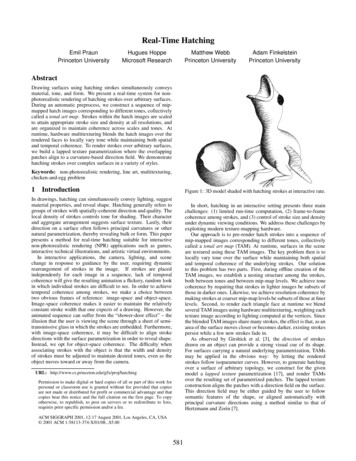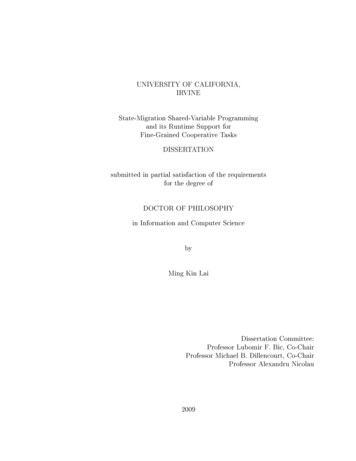
Transcription
UNIVERSITY OF CALIFORNIA,IRVINEState-Migration Shared-Variable Programmingand its Runtime Support forFine-Grained Cooperative TasksDISSERTATIONsubmitted in partial satisfaction of the requirementsfor the degree ofDOCTOR OF PHILOSOPHYin Information and Computer SciencebyMing Kin LaiDissertation Committee:Professor Lubomir F. Bic, Co-ChairProfessor Michael B. Dillencourt, Co-ChairProfessor Alexandru Nicolau2009
c 2009 Ming Kin Lai
DEDICATIONTomy family, particularly my brotheriii
TABLE OF CONTENTSPageLIST OF FIGURESviiLIST OF TABLESixACKNOWLEDGMENTSxCURRICULUM VITAExiABSTRACT OF THE DISSERTATION1Introduction1.12xii1Motivation . . . . . . . . . . . . . . . . . . . . . . . . . . . . . . . . .11.1.1Programming model. . . . . . . . . . . . . . . . . . . . . . .11.1.2Run-time support . . . . . . . . . . . . . . . . . . . . . . . . .21.2Contribution . . . . . . . . . . . . . . . . . . . . . . . . . . . . . . . .51.3Overview and organization . . . . . . . . . . . . . . . . . . . . . . . .6MESSENGERS Programming Model2.1variables . . . . . . . . . . . . . . . . . . . . . . . . . . . . . . . . . .82.1.1Location and migration of program . . . . . . . . . . . . . . .82.1.2State-migration programming92.1.3State-migration programming vs message passing2.1.4Location-scoped variables2.1.5State-migration location-scoped-variable programming2.1.6State-migration location-scoped-variable programming vs mes-2.1.72.22.37Distributed programming using program migration and location-scoped. . . . . . . . . . . . . . . . . . . . . . . .10. . . . . . . . . . . . . . . . . . . .17. . . .18sage passing . . . . . . . . . . . . . . . . . . . . . . . . . . . .19Migration during execution of subprogram21. . . . . . . . . . . . .242.2.1Concurrent programming using multiple tasks sharing variablesTask . . . . . . . . . . . . . . . . . . . . . . . . . . . . . . . .242.2.2Shared-variable programming. . . . . . . . . . . . . . . . . .25MESSENGERS programming model. . . . . . . . . . . . . . . . . .25. . . . . . . . . . . . . . . . . . . . . . .262.3.1Messenger migration2.3.2Physical node and logical node. . . . . . . . . . . . . . . . .262.3.3Messenger migration on logical nodes and physical nodes . . .28iv
35302.3.5Dynamic binding of node variables322.3.6Scheduling of Messengers . . . . . . . . . . . . . . . . . . . . .352.3.7Computation and data distribution using MESSENGERS . . .362.3.8Summary38. . . . . . . . . . . . . . . . . . . . . . . . . . . . . . . . . . . . . . . . . . .403.141MESSENGERS compiler . . . . . . . . . . . . . . . . . . . . . . . . . . . . . . . . . . . . . . . . . .453.2.1Single-CPU MESSENGERS runtimeImplementation of logical nodes and Messengers . . . . . . . .463.2.2Overview of execution of daemon493.2.3Formation of daemon network . . . . . . . . . . . . . . . . . .503.2.4Injection of Messenger. . . . . . . . . . . . . . . . . . . . . .513.2.5Ready queue and scheduling of Messengers . . . . . . . . . . .523.2.6Execution of Messenger . . . . . . . . . . . . . . . . . . . . . .533.2.7References to node variables . . . . . . . . . . . . . . . . . . .553.2.8Multithreading of daemon and sending/receiving queues. . .573.2.9Support for ne-grained tasks and migration . . . . . . . . . .57. . . . . . . . . . . . . . . .Case Study of MESSENGERS Programming594.1Mapping of physical and logical nodes on network . . . . . . . . . . .634.2Mapping of physical and logical nodes on uni-processor computer64. .Vertical Scaling and Multithreading715.1715.25.36MESSENGERS language . . . . . . . . . . . . . . . . . . . . .Original MESSENGERS System3.242.3.4Vertical and horizontal scaling . . . . . . . . . . . . . . . . . . . . . .Processor support for multiple CPUs on computer . . . . . . . . . . .735.2.1Symmetric multiprocessing . . . . . . . . . . . . . . . . . . . .735.2.2Chip multiprocessing . . . . . . . . . . . . . . . . . . . . . . .745.2.3Simultaneous multithreading . . . . . . . . . . . . . . . . . . .75Operating system support for multiple CPUs and multithreading . . .765.3.1General. . . . . . . . . . . . . . . . . . . . . . . . . . . . . .765.3.2Support by Linux . . . . . . . . . . . . . . . . . . . . . . . . .785.3.3Impact of asymmetric multi-cores . . . . . . . . . . . . . . . .805.3.4Impact of NUMA topology . . . . . . . . . . . . . . . . . . . .815.3.5Binding process/thread to CPU . . . . . . . . . . . . . . . . .81Multiple-CPU MESSENGERS Runtime System836.1Inadequacy of single-CPU MESSENGERS runtime. . . . . . . . . .836.2Flow of control: process vs thread . . . . . . . . . . . . . . . . . . . .846.2.1Scaling using processes . . . . . . . . . . . . . . . . . . . . . .856.2.2Parallelization using threads . . . . . . . . . . . . . . . . . . .856.3Implementation of multiple-CPU MESSENGERS runtime using multiple processes . . . . . . . . . . . . . . . . . . . . . . . . . . . . . . .6.486Implementation of multiple-CPU MESSENGERS runtime using multiple threads . . . . . . . . . . . . . . . . . . . . . . . . . . . . . . . .v91
7.916.4.2Possible choices for domain. . . . . . . . . . . . . . . . . . .926.4.3Implementation . . . . . . . . . . . . . . . . . . . . . . . . . .93Performance evaluation . . . . . . . . . . . . . . . . . . . . . . . . . .976.6Discussion . . . . . . . . . . . . . . . . . . . . . . . . . . . . . . . . .103Related Work1047.1Navigational programming . . . . . . . . . . . . . . . . . . . . . . . .1047.2Thread migration systems. . . . . . . . . . . . . . . . . . . . . . . .1067.3Forms of mobility . . . . . . . . . . . . . . . . . . . . . . . . . . . . .1097.4Mobile agents and strong/weak mobility. . . . . . . . . . . . . . . .110. . . . . . . . . . . . . . . . . . . . . . . .1137.5.1High Performance FortranMigration of abstract processors . . . . . . . . . . . . . . . . .1157.5.2Hierarchy of abstract processors on one computer115. . . . . . .Future Work1178.1Hierarchy of physical and logical nodes8.2Static binding of node variables8.3Additional experiment on computers with larger number of CPUs and/or8.49Domain decomposition of MESSENGERS runtime program6.57.586.4.1. . . . . . . . . . . . . . . . .117. . . . . . . . . . . . . . . . . . . . .117asymmetric CPUs . . . . . . . . . . . . . . . . . . . . . . . . . . . . .118Data redistribution by migrating physical and/or logical nodes . . . .118Conclusion120Bibliography121vi
LIST OF FIGURESPage2.1Program migration. . . . . . . . . . . . . . . . . . . . . . . . . . . .2.2Program transformation - sequence, using state-migration programming 112.3Program transformation - selection, using state-migration programming2.4Program transformation - repetition, using state-migration programming 122.5Message-passing programming vs programming using goto's2.6Program modi ability - state-migration programming vs message-passing 162.7Location-scoped variables2.8Saving the value of a location-scoped variable into a migratable variable 182.9Program transformation - sequence, using state-migration location-. . . . . . . . . . . . . . . . . . . . . . . . . . . .scoped-variable programming. . . . . . . . . . . . . . . . . . . . . .9111417202.10 Program transformation - selection, using state-migration locationscoped-variable programming. . . . . . . . . . . . . . . . . . . . . .212.11 Program transformation - repetition, using state-migration locationscoped-variable programming. . . . . . . . . . . . . . . . . . . . . .222.12 Migratable and location-scoped variables of a subprogram in a statemigration location-scoped-variable program . . . . . . . . . . . . . . .232.13 Locations, physical nodes and logical nodes . . . . . . . . . . . . . . .272.14 Messenger migration with respect to logical nodes and physical nodes292.15 A simple Messenger de nition and a simple node le. . . . . . . . .302.16 Location-based scope for location-scoped variables . . . . . . . . . . .332.17 Using the MESSENGERS programming model for computation anddata distribution. . . . . . . . . . . . . . . . . . . . . . . . . . . . .382.18 Incremental partitioning of computation and data using the MESSENGERS programming model . . . . . . . . . . . . . . . . . . . . . . . .3.1Translation of declarations of Messenger variables to the de nition ofa structure by the MESSENGERS preprocessor3.2. . . . . . . . . . . .42Translation of a Messenger de nition into a Messenger C program consisting ofmsgr functions. . . . . . . . . . . . . . . . . . . . . . .3.3Initialization functions in a Messenger C program3.4Three levels of networks in the MESSENGERS execution environment3.6struct NCBstruct MCB3.7Simpli ed de nition of3.539andstruct NVA. . . . . . . . . . . . . . . . . . . . . . . . . . . . . . . . . . . . . . . . . . . . . . . . . . . . . . . . . . . . . . .run daemon()viiin the runtime program. . . .434445474849
3.8De nition of3.9De nition of3.10 De nition ofcreate mcb() in the runtime programexec msgrs() in the runtime programexec mcb() in the runtime program . . . . . . . . . .52. . . . . . . . . .53. . . . . . . . . .543.11 De nitions of functions sending a MCB to an remote daemon. . . .564.1Sequential program for Crout factorization . . . . . . . . . . . . . . .604.2Working set of an iteration of the outermost loop in the Crout factorization algorithm4.34.4. . . . . . . . . . . . . . . . . . . . . . . . . . . . .60De nition of Messenger for Crout factorization . . . . . . . . . . . . .61Mapping of physical and logical nodes on a network of uni-processorcomputers . . . . . . . . . . . . . . . . . . . . . . . . . . . . . . . . .634.5Mapping of physical and logical nodes on a uni-processor computer686.1Address spaces of the processes running the daemons on a dual-CPUcomputer with the multiple-CPU MESSENGERS runtime6.2. . . . . .90Three levels of networks in the MESSENGERS execution environmentwhen two daemons, each embeds a logical node, are created on a dual-6.36.4CPU computer. . . . . . . . . . . . . . . . . . . . . . . . . . . . . . .91struct NCB95De nition ofstruct node ready queue . . . . . . . . . . .run node() in the multiple-CPU MESSENGERSandtime program with multiple computation threads6.5. . .run-. . . . . . . . . . .Migration of an MCB from (the ready queue of ) one logical node to(the ready queue of ) another.exec msgrs(). . . . . . . . . . . . . . . . . . . . . .96in the new runtime program. . . . . . . .976.6De nition of6.7Address space of a multithreaded process running the daemon on adual-CPU computer with the multiple-CPU MESSENGERS runtime6.89698Three levels of networks in the MESSENGERS execution environmentwhen one daemon, consisting of two computation threads each embedding a logical node, is created on a dual-CPU computer.6.9. . . . . . .98Mapping of physical and logical nodes on a multiprocessor computer .102viii
LIST OF TABLESPage4.1Block distribution of a 3000 3000 upper triangular matrix, each entryof which is 4 bytes large, to 15 logical nodes each allocated 200 columns 664.2Block-cyclic distribution of a 3000 3000 upper triangular matrix, eachentry of which is 4 bytes large, to 2 logical nodes using a block size of200 columns . . . . . . . . . . . . . . . . . . . . . . . . . . . . . . . .4.3ization on a uniprocessor Sun Ultra-5 workstation with 2 MB cache6.167Performance of running the MESSENGERS program for Crout factor.69Performance of running the MESSENGERS program for Crout factorization on a Sun Fire V210 workstation with two UltraSPARC III-iprocessors6.2. . . . . . . . . . . . . . . . . . . . . . . . . . . . . . . . .Performance of running the MESSENGERS program for Crout factorization on a TYAN computer with two AMD Opteron 248 processors6.3100100Performance of running the MESSENGERS program for Crout factorization on a HP computer with two dual-core AMD Opteron 270processors6.4. . . . . . . . . . . . . . . . . . . . . . . . . . . . . . . . .100Performance of running the MESSENGERS program for Crout factorization on a Sun Fire V210 workstation with two UltraSPARC III-iprocessors6.5. . . . . . . . . . . . . . . . . . . . . . . . . . . . . . . . .101Performance improvement in running the MESSENGERS program forCrout factorization by using two logical nodes over one logical nodeper physical node with the multi-process version of the MESSENGERSruntime on a dual-processor Sun Fire V210 workstation . . . . . . . .6.6101Performance improvement in running the MESSENGERS program forCrout factorization by using two logical nodes per physical node withthe multi-process version over (using two logical nodes with) the multicompuation-thread version of the multiple-CPU MESSENGERS runtime on a dual-processor Sun Fire V210 workstation . . . . . . . . . .ix102
ACKNOWLEDGMENTSI would like to thank my advisors Professors Lubomir Bic and Michael Dillencourt fortheir advices, insight, and encouragement throughout this work. The MESSENGERSgroup led by them is an easy-going and pleasant environment that fosters free andindependent research. They are also nice people with great sense of humor.I feel privileged to have Professor Alex Nicolau on my dissertation committee, andhave Professors Lichun Bao of the Department of Computer Science and David A.Smith of the Department of Sociology on my PhD Candidacy Advancement Committee. I thank each of them for their time and helpful comments.My thanks also go to the past and current members of the MESSENGERS group, including Lei Pan, Koji Noguchi, Munehiro Fukuda, Christian Wicke, Wenhui (Wendy)Zhang, Matthew L. Badin, and Hairong Kuang. I am grateful to Munehiro and Christian for being instrumental in building the MESSENGERS system from which all ofus bene t for a long period of time.I de nitely would thank my family. Kai Huen Lai, my father, Mo Ching Leung, mymother, Ming Bik Lai, my sister, and especially Ming Lap Lai, my beloved brother,are always in my mind. So are my grandma, Wai Ying Leung, and my great aunt, WaiLing Leung. I owe many thanks to my friends, in particular Raymond Ka Sing Leung,Yi Tong Tse, George William Huntley III, and Hoi Wong. Indeed, I am indebted toall those who have helped and supported me.Lastly, I thank the U. S. Government for supporting me through the Graduate Assistantship in Areas of National Needs (GAANN) during most of my study.x
CURRICULUM VITAEMing Kin LaiEducation1981 1985The Chinese University of Hong KongHong KongDecember 1985Bachelor of Business Administration (Honours)The Chinese University of Hong Kong1987 1988The University of North Carolina at Chapel HillChapel Hill, North Carolina, U.S.A.December 1988Master of AccountingThe University of North Carolina at Chapel Hill1993 1995California State University, Los AngelesLos Angeles, California, U.S.A.1999 2000The University of GeorgiaAthens, Georgia, U.S.A.2000 2009University of California, IrvineIrvine, California, U.S.A.December 2003Master of ScienceUniversity of California, IrvineJune 2009Doctor of PhilosophyUniversity of California, IrvineSelected awards1994Lewis & Urner Scholarship, California State University, LosAngeles1995Charles Clark Scholarship, California State University, LosAngeles2000 2007Graduate Assistantship in Areas of National Needs, U.S. Department of Educationxi
ABSTRACT OF THE DISSERTATIONState-Migration Shared-Variable Programmingand its Runtime Support forFine-Grained Cooperative TasksByMing Kin LaiDoctor of Philosophy in Information and Computer ScienceUniversity of California, Irvine, 2009Professor Lubomir F. Bic, Co-ChairProfessor Michael B. Dillencourt, Co-ChairThis dissertation dissects a programming model that makes concurrent programmingon a network of computers easier than using message passing, expands the understanding of this model by clarifying its concepts, shows how it is used to improve data reusein the cache on a uni-processor, and demonstrates, by using two implementations ofa runtime system, that it also supports programming on a multiple-CPU computer.Message passing is the predominant programming model for distributed concurrentprogramming. An alternative programming model proposed in previous works, calledMESSENGERS in this dissertation, was enhanced and de ned. The model was improved to di erentiate and expand the roles played by two abstractions in the model,namely, physical node and logical node. An in-depth comparison with the messagepassing model was analyzed to o er insight on the ease-of-programming advantage ofthis MESSENGERS model.A language, a compiler and a runtime system were developed in prior works to supportprogramming ne-grained cooperative tasks under the MESSENGERS model.xii
Whereas prior e orts focused upon using MESSENGERS on a network of uni-processorcomputers leveraging its increased processing and memory power, this dissertationshows how to take advantage of MESSENGERS's cooperative scheduling to improvedata reuse in the cache of a single computer.The runtime system was modi ed to demonstrate that this model can be used tobene t from multiple processors or cores often found in contemporary computers.Two di erent versions of the runtime system were implemented. One creates as manyprocesses (by creating multiple instances of the runtime) as there are CPUs on acomputer, with a single computation thread in each process.The other creates asmany threads as there are CPUs, all within the runtime process on the multiple-CPUcomputer.These versions were analyzed on di erent platforms and they achievedsatisfactory improvement over the original runtime. A program running on the versionusing multiple processes was able to bene t from the technique that improves cacheperformance and thus achieve better speedup.xiii
Chapter 1Introduction1.1Motivation1.1.1 Programming modelMessage passing is the predominant programming model for concurrent programmingon distributed computer systems. Among many alternative models proposed by researchers, there exists one that is based on the migration of concurrent tasks and thedynamic binding of variables based on locations. This model, called MESSENGERSin this dissertation, allows the programmer to transform a sequential program to aprogram under this model more easily than to a message-passing program, and sucha program can be more easily transformed in order to adapt to di erent computation distribution schemes than a message-passing program can. This model can beuniformly used for shared-memory and distributed-memory programming. However,concepts in the MESSENGERS model had not been clearly de ned.No attemptshad been made to apply it on a single computer in a way that can improve data reuse1
in the cache. Nor were there attempts to explain how this model can be applied to acomputer with multiple CPUs so that these CPUs can be adequately utilized.1.1.2 Run-time supportThere were systems such as Ariadne that uses Standard C Library functions suchassetjmp()andlongjmp()(see Engelschall's paper [18], for example, for details),and Arachne that uses an alternative approach, to capture and restore the state of athread. These systems send the captured state of a migrating thread at the sourcemachine and receive and restore it at the destination machine of the same network.A model based on task migration is therefore supported.A thread, which can beviewed as a particular realization of a task, can then migrate to a remote computerto exploit data locality or to balance workload.Multiprocessing has become the mainstream processor architecture for both serverand desktop systems. Multithreading and technologies based thereon have been theconventional method to utilize the multiple CPUs on these machines. On a singleCPU machine, creating multiple threads allows the overlap of computation and communication, as well as the expression of logical concurrency.On a multiple-CPUmachine, that logical concurrency becomes physical parallelism and the CPUs can beutilized.As more and more processors and/or cores are put into a computer, it is di cult forcurrent technology to allow each processor or core to access all the memory locationsin the compute
UNIVERSITY OF CALIFORNIA, VINEIR State-Migration Shared-Variable Programming and its Runtim

